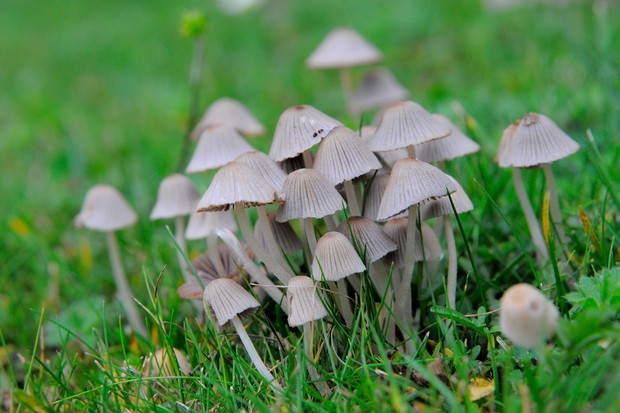
Toadstools are the fruiting bodies of fungi that appear above ground. They mainly appear in late summer and autumn and are more prevalent in warm, damp seasons. There are thousands of species of fungi and most are beneficial, playing a vital role in the garden ecosystem by feeding on dead material and releasing nutrients back in to the soil. Mycorrhizal fungi attach to plant roots and ‘supercharge’ the root system, enabling it to collect a greater amount of water and nutrients. However, occasionally toadstools may cause problems in the garden or be a visible indication of fungi that are harmful to plants, such as fairy rings or honey fungus. Some toadstools are extremely poisonous and should be removed where small children are playing or where pets roam.
Mushroom or toadstool: what’s the difference?
The term ‘toadstool’ is often used to refer to fungi with a stem and a cap, or to fungi that are poisonous, while “mushroom” is more often used to define fungi that are edible. However, these are generally used, loose and subjective terms rather than clearly defined distinctions. There’s no biological or scientific difference between a toadstool and a mushroom.
The origin of the word ‘toadstool’ is unclear, but the word has been in use for hundreds of years. It may have been named because flies are drawn to decaying toadstools and then entice toads, which feed on flies.
Problem garden fungi
Fairy rings mushrooms
Two of the most common toadstools associated with problem fungi in the garden are fairy rings and honey fungus. Fairy rings appear in lawns, producing circles that can develop up to several metres across, accentuated by dark green, lush grass outside the toadstool ring, which is feeding on the nutrients released by the fungi (while it’s seen as a problem by gardeners, fairy rings are actually good for the lawn). Honey fungus spreads underground. Some species of honey fungus live in harmony with garden plants, others kill the roots of various woody and perennial plants. You can identify honey fungus by the honey-coloured toadstool mushrooms that appear above ground, and also dead, dying, or unhealthy plant growth around the garden.
Identifying edible fungi
Only pick and eat fungi if you are absolutely certain that it is edible. While there are good field guidebooks, apps and websites to edible fungi, the best advice is direct from a knowledgeable expert. Look for information on guided walks and foraging online, in your local press, and on websites such as the British Mycological Society or the Wildlife Trusts. The growing popularity of foraging for wild foods is leading to an increase in cases of poisoning causing severe stomach upsets and, tragically, even fatalities. There are fungi that look like edible mushrooms but are in fact extremely poisonous. If poisoning is suspected, seek immediate medical attention, taking a sample of the fungus with you if possible.
Identifying poisonous fungi
Some toadstools or mushrooms are extremely toxic and must not be eaten, and preferably not even handled unless wearing gloves. These include Fly agaric (Amanita muscaria), which looks like many people’s image of a poisonous toadstool with a scarlet-red, white-spotted cap, the Death cap (Amanita phalliodes) which has green-yellow caps, and Destroying Angel (Amanita virosa) that has white-cream caps. If poisonous fungi are growing in areas used by small children or pets, remove and destroy, wearing gloves.
